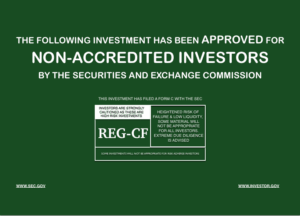
Earlier this year, on May 16, 2016, the final portion of the JOBS Act became actionable. The much anticipated Title III provisions and Regulation Crowdfunding (Reg CF) went into effect, marking the official beginning of retail crowdfunding in the United States. While the industry is still gearing up and it is too early to pass judgment on the long-term prospects of Reg CF in general, it is possible to assess how certain characteristics of retail crowdfunding are developing. With respect to the menu of financing instruments being offered to prospective investors, many early market participants may be sabotaging the crowdfunding experiment by making widespread use of a relatively new startup-financing instrument—the simple agreement for future equity or “SAFE,” as it is called. This vehicle may frustrate the ability of investors to share in the upside of successful crowdfunding companies, thus diminishing the benefit of “democratizing” access to early-stage companies.
 The SAFE was developed by Y Combinator, the world-famous startup accelerator based in Silicon Valley and now operating around the world, as a means of investing in startups that expected to raise institutional venture capital at a later date. Although the SAFE resembles a classic seed-stage convertible note in many respects, it lacks the convertible note’s maturity date and does not accrue interest while it remains outstanding. The vehicle does not pay dividends, and the SAFE holder has no right to vote on matters submitted to shareholders. The SAFE is, in essence, a contractual derivative instrument that amounts to a deferred equity investment. It will prove valuable to the holder if, and only if, the company that issues it raises a subsequent round of financing or is sold.
The SAFE was developed by Y Combinator, the world-famous startup accelerator based in Silicon Valley and now operating around the world, as a means of investing in startups that expected to raise institutional venture capital at a later date. Although the SAFE resembles a classic seed-stage convertible note in many respects, it lacks the convertible note’s maturity date and does not accrue interest while it remains outstanding. The vehicle does not pay dividends, and the SAFE holder has no right to vote on matters submitted to shareholders. The SAFE is, in essence, a contractual derivative instrument that amounts to a deferred equity investment. It will prove valuable to the holder if, and only if, the company that issues it raises a subsequent round of financing or is sold.
Do SAFEs Mean More Risk for the Investor?
 In our opinion, the key issue with the use of SAFEs in crowdfunding is that many of the companies issuing these instruments are unlikely ever to raise institutional venture capital. If a crowdfunding issuer never raises this type of capital, then the retail investors who hold that issuer’s SAFEs may find themselves in possession of a security that, in addition to granting the holder no voting rights or other investor protections, may never provide them with a return on their capital—or a return of their original investment amount. And this may occur even if the company is successful. Sophisticated investors who invest in SAFEs in the context of early-stage technology companies knowingly assume these risks because they expect these companies to successfully raise venture capital in short order following their investment. Retail investors who invest in SAFEs issued by Reg CF companies that are unlikely to raise venture capital, by contrast, may not fully appreciate the risks that they are taking.
In our opinion, the key issue with the use of SAFEs in crowdfunding is that many of the companies issuing these instruments are unlikely ever to raise institutional venture capital. If a crowdfunding issuer never raises this type of capital, then the retail investors who hold that issuer’s SAFEs may find themselves in possession of a security that, in addition to granting the holder no voting rights or other investor protections, may never provide them with a return on their capital—or a return of their original investment amount. And this may occur even if the company is successful. Sophisticated investors who invest in SAFEs in the context of early-stage technology companies knowingly assume these risks because they expect these companies to successfully raise venture capital in short order following their investment. Retail investors who invest in SAFEs issued by Reg CF companies that are unlikely to raise venture capital, by contrast, may not fully appreciate the risks that they are taking.
In addition to these general concerns about the use of SAFEs in crowdfunding, we also believe that the specific SAFEs currently offered by crowdfunding portals such as WeFunder and Republic contain terms that are likely to frustrate the ability of investors to share in the upside of successful crowdfunding companies. The WeFunder SAFE, for example, states that a financing conversion only occurs under the contract when the issuer closes a bona fide preferred stock financing raising any amount at a fixed pre-money valuation. The SAFEs do not convert if the company raises equity capital by selling common stock. Under the terms of the WeFunder SAFE, a company could theoretically raise unlimited amounts of private capital selling common stock and distributing profits to those investors and the founders via dividends without ever triggering a conversion of the SAFEs or allowing the SAFE holders to participate in those dividend payments. The Republic SAFE, which includes a troubling redemption feature by which a company can call its SAFEs from all non-accredited investors, also (like WeFunder’s SAFE) neglects to account for a scenario in which the stockholders of the company receive their return in the form of dividends and not in a liquidity event such as a sale or IPO.
 There are several possible solutions to the challenges enumerated above. First, the crowdfunding portals could seek to limit the use of SAFEs to the “right” sort of companies—those that are likely to raise future capital from institutional investors. While policing the types of securities offered by crowdfunding companies may sound like a tall task for the portals, many of them already market themselves as significantly curating the offerings they make available on their platforms. Second, the portals could amend the forms of SAFE currently on offer to address some of the specific issues we have raised. This would be a positive development, to be sure, but it would not address the deeper problems that flow from the fact that many of these crowdfunding issuers will never raise institutional venture capital. Third, and finally, the funding portals could remove the SAFE from their menu of financing instruments. We believe that this last approach represents the simplest and best solution to the various problems identified above. A Reg CF company that is a likely candidate for raising future venture capital and that wants to issue a SAFE-like security could instead issue a convertible note, which is similar to the SAFE in many respects but which accrues interest, has a maturity date and offers retail investors other protections that are associated with debt instruments .
There are several possible solutions to the challenges enumerated above. First, the crowdfunding portals could seek to limit the use of SAFEs to the “right” sort of companies—those that are likely to raise future capital from institutional investors. While policing the types of securities offered by crowdfunding companies may sound like a tall task for the portals, many of them already market themselves as significantly curating the offerings they make available on their platforms. Second, the portals could amend the forms of SAFE currently on offer to address some of the specific issues we have raised. This would be a positive development, to be sure, but it would not address the deeper problems that flow from the fact that many of these crowdfunding issuers will never raise institutional venture capital. Third, and finally, the funding portals could remove the SAFE from their menu of financing instruments. We believe that this last approach represents the simplest and best solution to the various problems identified above. A Reg CF company that is a likely candidate for raising future venture capital and that wants to issue a SAFE-like security could instead issue a convertible note, which is similar to the SAFE in many respects but which accrues interest, has a maturity date and offers retail investors other protections that are associated with debt instruments .
Other Investment Options May Be Better
If the SAFE were to disappear, the company could issue debt, common equity or preferred equity (the latter two providing investors with the full benefit of being shareholders of the company, including most importantly, the protection of fiduciary duties owed by the company’s board of directors). All of these alternatives are, in our view, more suitable vehicles for investing in crowdfunding companies than is the SAFE.
In summary, while the SAFE may have a role to play in providing capital to early-stage companies outside of the crowdfunding context, it is not the right tool for channeling retail investment capital to crowdfunding companies.
(Editors Note: This post is based on the authors’ recent paper “Crowdfunding and the Not-So-Safe SAFE.” The full paper can be downloaded via SSRN for free here. A version of this article was previously published on the Harvard Law School Forum on Corporate Governance and Financial Regulation.)

John Coyle is an Associate Professor at the University of North Carolina School of Law. He teaches and writes about venture capital. Prior to joining the faculty at UNC, he clerked for Judge Reena Raggi on the U.S. Court of Appeals for the Second Circuit and worked as an associate at Covington & Burling LLP in Washington D.C.
 Joe Green writes Thomson Reuters Practical Law’s startup and venture capital content and is a principal member of the Practical Law Startup Resource Group, working across practice areas to develop relevant know-how materials for practitioners in the startup space. He writes and speaks frequently on crowdfunding and other startup law topics. Prior to joining Practical Law, Joe was a senior attorney at Gunderson Dettmer, where he advised startups, entrepreneurs, and premier venture capital investors on a wide range of legal and business issues. After graduating from UVA Law, he began his career as a securities lawyer with Simpson Thacher & Bartlett in New York.
Joe Green writes Thomson Reuters Practical Law’s startup and venture capital content and is a principal member of the Practical Law Startup Resource Group, working across practice areas to develop relevant know-how materials for practitioners in the startup space. He writes and speaks frequently on crowdfunding and other startup law topics. Prior to joining Practical Law, Joe was a senior attorney at Gunderson Dettmer, where he advised startups, entrepreneurs, and premier venture capital investors on a wide range of legal and business issues. After graduating from UVA Law, he began his career as a securities lawyer with Simpson Thacher & Bartlett in New York.

